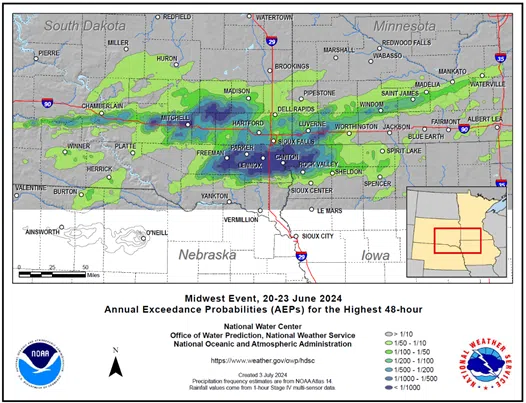AUGUST 15, 2024:
South Dakota has received a Presidential Disaster Declaration due to the flooding event that happened from June 16-July 8, 2024.
The declaration clears the way to provide individual financial assistance for residents and businesses in four counties, as well as assistance for qualifying government entities or non-profits in all 25 of the eligible counties.
Governor Kristi Noem says the four counties were individuals and businesses may apply for assistance are Davison, Lincoln, Turner and Union. She says impacted individuals located within these counties must contact FEMA to register for disaster assistance. They can do so by going online to disasterassistance.gov, calling 800-621-3362 or using the FEMA mobile app.
Additionally, Noem says federal funding is available to state, tribal, eligible local governments and certain private nonprofit organizations in 25 counties. Those are Brule, Buffalo, Gregory, Hand, Jackson, Tripp, Aurora, Bennett, Bon Homme, Charles Mix, Clay, Davison, Douglas, Hanson, Hutchinson, Lake, Lincoln, McCook, Miner, Minnehaha, Moody, Sanborn, Turner, Union and Yankton. Noem says assistance in these counties is on a cost-sharing basis for emergency work, and the repair or replacement of facilities damaged by the flooding. She says the cost share will be 75% federal, 15% state and 10% local.
Noem says Disaster Recovery Center dates and locations will be announced soon, but it’s not necessary to go to a center to apply for FEMA assistance. She says the local entities will work with state and FEMA officials to obtain this assistance.
JULY 28, 2024:
Governor Kristi Noem formally requested (July 26, 2024) a major disaster declaration from the President for 25 counties due to the severe flooding that occurred in South Dakota between June 16 and July 8, 2024. Governor Noem signed Executive Order 2024-06 declaring the disaster. According to the National Weather Service, the rain event that created this flooding was a 1,000-year event.
“Today, we are submitting our request for a presidential disaster declaration to address the damage from a historic 1,000-year flood that impacted South Dakota,” said Governor Kristi Noem. “We have been working with families, local governments and officials, and FEMA for weeks to assess the damage. I am so proud of what South Dakotans have been able to do to start piecing our communities back together.”
In the aftermath of the flooding, teams from the Office of Emergency Management (OEM) and the Federal Emergency Management Agency (FEMA) have been on the ground conducting thorough damage assessments across the impacted areas, working closely to assess the extent of the damage and coordinate the necessary response efforts.
“This thorough damage assessment was normal protocol for a presidential disaster declaration, and it’s an important part of the process to make sure all eligible counties and citizens are included,” said Kristi Turman, Director of the Division of Emergency Services at the South Dakota Department of Public Safety.
During the flood, at least 11 river gauges hit new preliminary record-high levels. The Big Sioux River at Sioux City crested nearly eight feet higher than previous records. New record crests were set at the following locations:
- Big Sioux River at Canton, Hawarden, Akron, Richland, Jefferson, and Sioux City;
- Vermillion River at Davis, Wakonda, and Vermillion;
- West Fork Vermillion River at Parker; and
- Turkey Ridge Creek at Centerville.
The request for a presidential disaster declaration highlights a critical need in the following South Dakota counties: Aurora, Bennett, Bon Homme, Brule, Buffalo, Charles Mix, Clay, Davison, Douglas, Gregory, Hand, Hanson, Hutchinson, Jackson, Lake, Lincoln, McCook, Miner, Minnehaha, Moody, Sanborn, Tripp, Turner, Union, and Yankton.









Comments